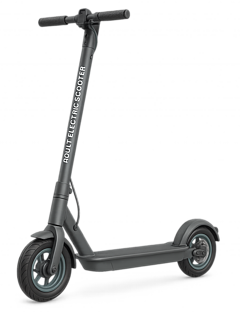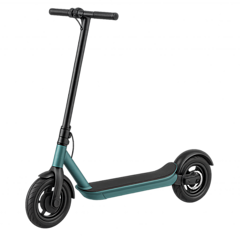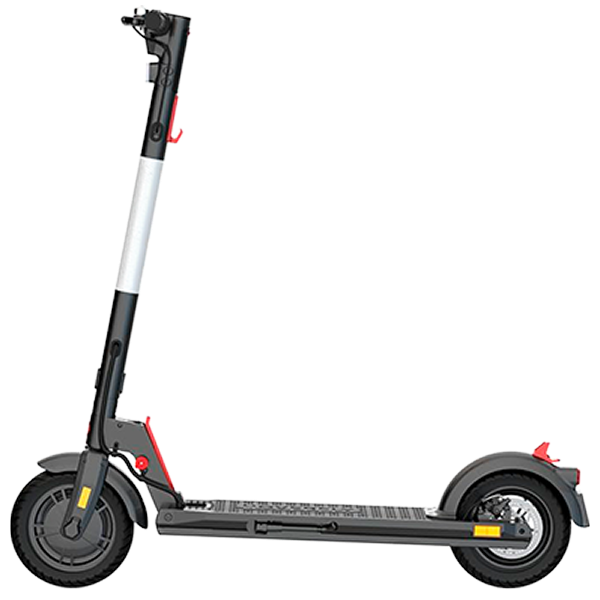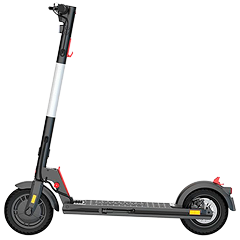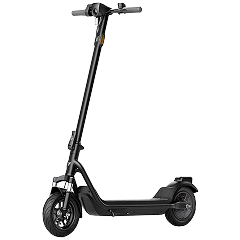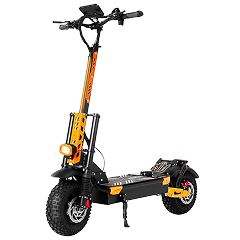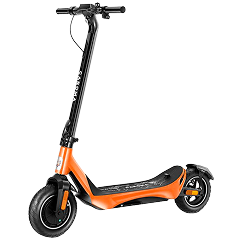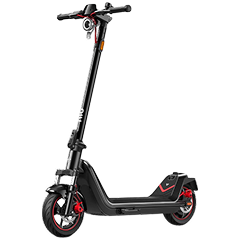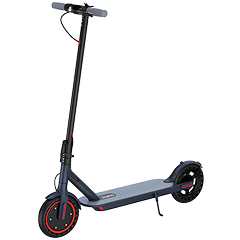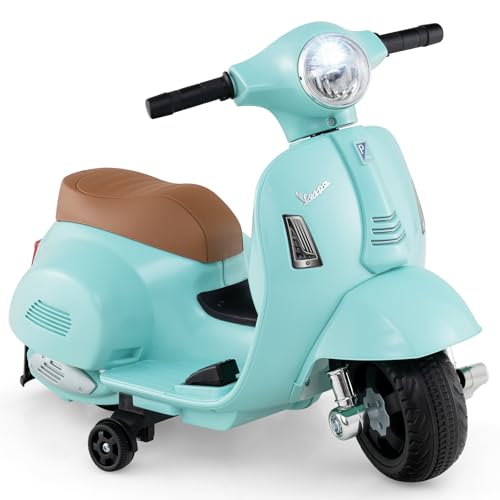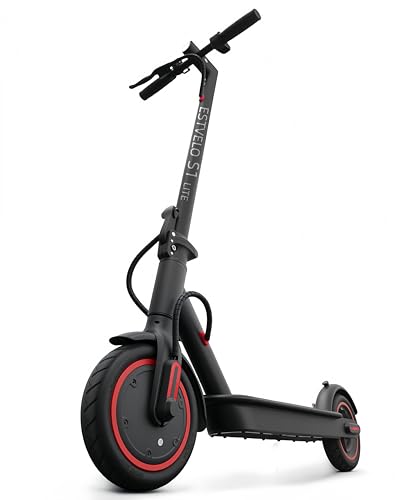Speed is one of those ego metrics that everyone checks when it comes to anything with wheels, and electric scooters are no different. Behind range and power, speed and acceleration are the specs that often determine a purchase.
Most electric scooters for adults typically cruise between 10 and 30 mph, so anything above that is considered relatively fast in scooter terms.
However, riding above 30 mph can get pretty sketchy, due to the general structure and design limitations of most scooters. That said, dedicated fast electric scooters have design elements that make them relatively safer than standard models.
In this guide, we’ll discuss those design elements, what affects speed in scooters, and what you should look for when buying a fast electric scooter.
What You Should Look For When Buying a Fast Electric Scooter
The following factors all play important roles in determining whether a scooter can deliver both the performance and safety you need.
Top Speed and Acceleration
Top speeds for adult electric scooters usually range from 10 mph on the lower side all the way to the fastest electric scooters, which sit at around 50+ mph. Most electric scooters sit in the 10 to 30 mph range, so as discussed, anything that can surpass 30 mph and hold steady is a fast electric scooter. Anything past 40 mph puts you in the lower zone of performance electric scooters.
For this number, you’ll just have to go with the manufacturer specs for indication. Luckily, it’s not exaggerated as much as range. You’ll usually find a difference of only 2 to 5 mph between manufacturer specs and real-world tests. You can also check scooter reviews, as top speed is a specification most reviewers test.
The other stat to look out for is acceleration. Many people actually want acceleration on an electric scooter rather than pure speed. There’s often some confusion here because, honestly, who would want to be going at a constant 60 mph on an electric scooter? It’s risky to say the least. What people actually want is those quick, short bursts, which is a more enjoyable way to get your heart thumping and adrenaline pumping.
Unfortunately for acceleration, almost no manufacturer will list it, and you absolutely can’t rely on motor power specs alone, so you’ll have to depend on reviews for this information. For acceleration, you usually get the 0 to 15 mph time for the scooters. Anything that gets to 15 mph in less than 3-4 seconds is considered fast.
But just to give you a rough idea of the acceleration of different motor ratings, below is a table from over 100 tested electric scooters.
Most sub-500W models take 5-9 seconds to reach 15 mph, while many 2,000W units drop to below 3 seconds. Performance gains level off once you pass roughly 3,000W, with additional power shaving only fractions of a second off acceleration times. Even scooters sharing the same power rating can differ by as much as two seconds due to variations in controller settings, weight, gearing, tire grip, etc.
Motor Power
For the motor, there are three things that will be of interest to you: the voltage, the current, and the power of the motor.
Voltage
Voltage is the electrical pressure that pushes current through the motor. The amount of voltage is indicated by a unit known as volts (V).
Every electric motor also has a KV rating, which is basically how many RPM (revolutions per minute) it turns per volt applied (in no-load conditions). Higher voltage gives the motor higher potential RPM. In plain English: a scooter with a higher system voltage can theoretically reach a higher top speed, because the motor can spin faster if nothing holds it back.
Common scooter voltages are 36 V, 48 V, 52 V, 60 V, 72V, and even up to 84 V in extreme models. If you see a scooter jump from 36 V to 60 V, that’s a huge step up in speed potential. (Of course, everything else, controllers, battery, and motor winding must be designed for that voltage.)
Here is the general relationship between the voltage and the maximum speed
A graph to better illustrate :
![[MK] Draft: The Fastest Electric Scooter Buyer\'s Guide](https://www.market.com/wp-content/uploads/2025/08/-mk-draft-the-fastest-electric-scooter-buyer-s-guide-1.png)
Bottom line: more volts = more speed headroom. This is why virtually all scooters that break 30 mph are 52V or higher. A 60 V or 72 V scooter has the “oomph” to push the motor to very high RPMs, 40 mph+, whereas a 36 V scooter simply can’t spin the motor fast enough to go much past ~25 mph (unless it uses a totally different motor design).
Current and Torque
Current is the flow of electricity that the controller lets through to the motor. It is measured in amperes (A).
While voltage gives the motor room to spin, it still needs torque to overcome your weight and any other load it might encounter, e.g, inclines. Current determines how much torque the motor can produce to overcome your weight, climb hills, fight wind drag, and reach top speed.
When you twist the throttle and don’t feel much pull, the limiting factor is likely insufficient current. The controller and battery must supply enough current for the motor to reach the speed that the voltage allows. Without adequate current, the motor runs out of pulling power under load.
The relationship is straightforward. More amps equal more torque and faster acceleration. This creates a design challenge, though. Higher current generates more heat, so motors and controllers have limits on how much they can handle continuously.
A well-designed fast scooter balances these factors with a controller that can supply high amperage to match the motor’s capability, paired with a battery that can deliver it sustainably.
Power Rating
Power is calculated by multiplying voltage and current: Power (Watts) = Voltage × Current. This spec combines speed and torque into one overall measure of the motor’s power output. For example, a system running at 60 V and 50 A is 3000 W, and one at 40 V and 75 A is also 3000 W.
In theory, both could deliver the same power, but their characteristics differ (the 60 V setup likely spins a motor faster, the 40 V one might have more low-end grunt due to higher amps). But generally, the larger the number of watts, the bigger the motor and the faster the scooter can go.
As a shopper, wattage is a handy way to compare overall motor strength. Generally, a scooter with a higher watt rating will accelerate harder and reach a higher top speed if geared appropriately. It’s an indicator of how much work the motor can do per second.
A setup that delivers 2,000W at the wheel can accelerate harder and hold a higher cruise speed than one capped at 500W, as long as gearing, wheel size, and cooling stay within safe limits. To get a fast scooter, try getting one with at least a 1500 W rating.
Keep in mind manufacturers sometimes list “peak” power (max burst) instead of continuous power. So one brand’s “1000 W” might be a nominal 1000 W motor, while another’s “1000 W” is a 500 W motor that peaks at 1000 W. We’ll talk about that nuance next.
Based on the same analysis of the 100 electric scooters, here’s how different power ratings correlate with top speed:
![Chart [MK] Draft: The Fastest Electric Scooter Buyer\'s Guide](https://www.market.com/wp-content/uploads/2025/08/-mk-draft-the-fastest-electric-scooter-buyer-s-guide-2.png)
The relationship isn’t perfectly linear but as the chart above suggests, you can’t ignore wattage if speed is what you crave. A 500 W model will not magically go 45 mph, no matter what hacks you try; it’s limited by power. Conversely, a 3000 W scooter that’s well-engineered can easily break 50 mph.
Nominal vs Peak Power
Another thing to check is whether the power rating given is nominal or peak power.
Nominal power is the continuous power the motor can handle without overheating (and is often the “true” rating of the motor). The higher the nominal power figure, the higher the continuous speed.
Peak power is the maximum power the system can push in short bursts (a few seconds) under ideal conditions. The same motor with 1,000W nominal power might produce 1,500W peak power for brief acceleration bursts. This extra power helps with quick starts and hill climbing, but it won’t be sustained for long periods.
Don’t be confused by inflated peak power numbers when comparing scooters; focus on nominal power ratings for a more accurate comparison of what the scooter can deliver consistently.
Motor Configuration (Single vs Dual, Front vs. Rear)
Most scooters have a single hub motor, either in the rear wheel or the front wheel. For high performance, rear-wheel drive is generally preferred. When you accelerate, weight transfers to the back wheel, pressing it down and giving it more traction. A rear motor can push against that weight transfer, maintaining grip.
A front motor, by contrast, can slip more easily because as you accelerate, the front end lightens. Front-drive scooters can also feel like they’re pulling you, which some riders find unnerving.
All in all, the ultimate configuration for maximum performance is dual motors. Dual motor setups offer the highest torque, fastest acceleration, and best capability for varied terrain, including off-road tracks and steep hills. However, dual motors also mean increased weight, complexity, and power consumption, which can reduce range.
Controllers and Throttle Response
The controller is an electronic module that takes your throttle input and translates it into power output by controlling the flow of electricity from the battery to the motor(s). In essence, it dictates how fast and how smoothly your scooter accelerates, and it often sets the upper limit on speed and torque. When evaluating a fast scooter, you’ll want to know a bit about its controller(s):
Voltage and Current Ratings
Controllers are rated by how much current (measured in amps) and voltage can pass through them. A higher voltage rating means the controller can handle more electrical pressure. You’ll typically see controllers rated for 36V, 48V, 52V, 60V, 72V, and 84V to match their respective systems (you’ll have a 60V controller for a 60V scooter, etc.).
Current rating is equally important. Measured in amps, it tells you how many amps the controller can supply to the motor. For example, an entry-level scooter might have a controller that maxes out at 15 A; a performance scooter might have dual 40 A controllers (one per motor).
A higher current rating means the controller can handle more electrical current, allowing faster throttle response and more power delivery to the motor. This translates to greater torque, faster acceleration, higher top speeds, and less chance of the scooter “bogging down” under load.
For a fast electric scooter, look for a controller rated at least 25–30 A continuous at 52–60 V, delivering 1.3–1.5 kW to the motor(s).
Square Wave vs Sine Wave Controllers
When reading scooter descriptions, you might see mention of square wave or sine wave controllers. This refers to how the controller drives the motor:
Square Wave
This older style controller switches the motor phases on and off abruptly, creating a blocky current wave. Think of it like a light switch rapidly flicking power on/off.
Square wave controllers are simpler and cheaper, and they tend to give the scooter a distinct kick or buzz. The throttle can feel jerky or abrupt; some riders actually enjoy the immediate punch (it can make a scooter feel more wild and aggressive).
However, the downsides are a rougher ride and sometimes a loud electrical whine from the motor. It’s also harder to modulate low speeds precisely, since even a tiny throttle input might jolt the scooter.
Sine Wave
Modern controllers often use sine wave output, which feeds a smooth, sinusoidal current to the motor coils. The result is silky smooth acceleration and a very quiet motor. With a sine wave controller, you’ll find it easier to maintain a steady speed and inch forward without jerks.
When you punch the throttle, the power ramps up more gradually (still very strong if it’s a powerful scooter, but less of a sudden jolt). Most people prefer sine wave for the control and refinement it offers, especially in a high-speed scooter where stability is key. The tradeoff? Sine wave controllers are more complex and usually pricier.
I personally prefer Sine wave controllers as the ride quality feels better.
Battery Capacity and Voltage
A powerful motor and beefy controller won’t get you far without a capable battery. The battery not only determines your range but also heavily influences performance. Here’s what to consider regarding batteries in fast scooters:
Voltage (Again)
The battery’s voltage should match the motor/controller system. As we discussed, higher voltage systems (52 V, 60 V, 72 V, etc.) allow for higher speeds. So naturally, fast scooters come with high-voltage battery packs.
Capacity (Ah and Wh)
The capacity of a battery is often given in amp-hours (Ah) or watt-hours (Wh). Watt-hours are a more direct measure of the energy stored (Wh = voltage × Ah). For example, a 60 V 18 Ah battery is 60*18 = 1080 Wh.
Why does capacity matter for a fast scooter? Two reasons: range and voltage sag.
First, range. Going fast gobbles up energy quickly due to wind resistance and high power draw. A small battery will deplete fast if you’re zipping around at full throttle. If you want to use your fast scooter for more than short bursts, look for a high Wh rating. I’d recommend something around 1000 Wh or more for a genuinely fast scooter, that might yield, say, 20–30 miles of hard riding.
Second, voltage sag. When you draw a lot of current from a battery, its effective voltage drops a bit. Larger batteries (more Wh and higher quality cells) tend to hold voltage better under load. This means the scooter can maintain its performance as the battery isn’t “struggling” to keep up. If you’ve ever noticed a scooter is slower when the battery is below 50% or when going uphill, that’s often sag.
Braking and Overall Safety
The most critical safety feature for any fast electric scooter is an effective braking system.
Anything that can stop from 15 mph in less than 12 feet (3.7 meters) is considered good performance, with some high-end scooters achieving stopping distances as short as 8-10 feet.
For good braking performance, dual brakes are a must in a fast electric scooter. This provides redundancy and maximum stopping power.
The best system you can get is hydraulic disc brakes, which provide the shortest stopping distances, followed by mechanical disc brakes, then drum brakes. I’m genuinely not a fan of regenerative braking as the primary system on fast scooters due to its longer stopping distances and potential for reduced effectiveness when batteries are fully charged, though some manufacturers like Apollo implement it well as a supplement. Overall, you want to have either disc or drum brakes as your main stopping system.
Here’s how different brake systems compare for stopping distance from 15 mph:
Handling and Stability
At high speeds, the scooter’s design and geometry play a huge role in keeping you upright. Here are the aspects of handling to pay attention to:
Handlebar Width and Height
Wide bars mean you have to move the bar more to affect the same turn, which is a good thing for stability (small accidental inputs won’t throw you off course as easily).
Many fast scooters come with nice, wide bars, sometimes 24–28 inches (60–70 cm) across. By contrast, some portable commuter scooters have narrow bars (under 20″/50 cm) to be compact, and those can feel very nervous if you try to push speed. Look for handlebars at least 22 inches wide for fast riding.
For height, find a scooter with handlebars that position your hands comfortably at about waist level to mid-torso height when standing upright. If the bars are too low, you’ll be hunching over.
While crouching is good for aerodynamics, being hunched can tire you out and reduce control because your weight isn’t balanced. Too high, and your arms might be up near your chest, which is also not ideal for fine control. Find a height where you have a secure, steady grip and your arms have a slight bend.
Steering Geometry (Rake Angle)
Steering geometry refers to how the front fork and stem are angled and positioned. One key parameter is the rake angle, which is the angle of the steering column relative to vertical. A smaller rake angle (more upright fork) makes the scooter turn more sharply with less input. It’s nimble but can be unstable at high speed because the steering is so sensitive.
A larger rake angle (fork angled out more) tends to increase something called trail, which has a self-centering effect on the steering and generally improves stability. Basically, scooters or bikes with a slack (more inclined) front end will feel more stable (think cruiser motorcycle), and those with a steep front end will feel quick to turn but can wobble more easily.
Most fast scooters are designed with stability in mind, so they won’t have crazy steep rake angles. You, as a consumer, can’t usually change the rake, but it’s good to be aware. If you read reviews that a scooter has a “nervous front end” at speed, it could be geometry or flex issues.
Steering Dampers
Now, let’s talk steering dampers. A steering damper is a device that adds friction or hydraulic damping to the steering motion. High-end scooters often come with a damper installed or at least optional.
What does it do? It tames the wobble. If you’ve ever seen a shopping cart wheel start flapping side to side, that’s the kind of oscillation a damper fights. At high speeds, especially if you hit a bump or if your weight distribution is off, the scooter’s steering can start to oscillate (speed wobble).
A damper resists quick movements of the handlebar, effectively slowing down that oscillation and helping the scooter self-correct instead of amplifying the wobble. Many riders report that adding a steering damper to their fast scooter massively increased their confidence at top speed, making the steering feel “heavier” but rock solid.
Deck Size and Kickplate
At high speeds, your stance on the scooter matters a lot. You want to be able to shift your weight, lean forward or back, and brace yourself during acceleration and braking. A good deck design facilitates this:
Deck Size
A larger deck gives you more room to plant your feet comfortably. If you’re cramped, you might be forced into a less stable stance. On a fast scooter, you’ll often adopt a staggered stance (one foot forward, one back, kind of like a skateboarder or surfer). This helps with balance and control. Ideally, the deck should be long enough and wide enough to accommodate this without your feet dangling off awkwardly. Look for decks at least 20 inches long and 8 inches wide.
Deck Grip
The surface of the deck should be grippy. You’ll commonly see grip tape (like skateboard tape) or rubberized decks on scooters. At 40 mph, the last thing you want is your foot slipping on smooth plastic. If you get a scooter and find the deck slippery, invest in some quality grip tape or traction pads.
Kickplate / Rear Foot Rest
A lot of fast scooters include a kickplate, which is an upward-angled portion at the rear of the deck (usually over the rear wheel). This isn’t just for looks; it allows your back foot to rest at an angle and gives you something to push against when accelerating.
Picture launching from a stop. Your body will naturally shift backward from inertia. A kickplate lets you brace that rear foot and lean into the acceleration, keeping weight forward. It also gives a bit of leverage to shift your weight toward the rear when needed (like hitting a bump or doing a small hop). Even when cruising, having your rear foot on a kickplate can feel more secure, as if you’re locked into the scooter.
It’s not strictly necessary, but it’s a very nice feature for high-power scooters.
Tires and Wheels
Wheel (Tire) Size
Bigger tires provide better stability and can roll over obstacles more easily, so for fast electric scooters, go for something with at least 10-inch diameter tires. Width is equally important. Wider tires provide a larger contact patch with the ground, which can improve traction and stability.
At high speed, a bit of extra width can make the scooter less squirrely as you have more rubber gripping the road, and the scooter reacts more gradually to small steering inputs. For that reason, look for tires at least 3 inches wide.
The profile (roundness of the tire cross-section) also matters. Performance street scooters usually have a rounded profile tire. This shape allows smooth leaning into turns and consistent contact with the road.
Pneumatic vs Solid Tires
This one’s easy, pneumatic (air-filled) tires are strongly preferred for fast scooters. Air-filled tires act as a secondary suspension, absorbing a lot of the small vibrations and impacts. They also conform to the road surface, maintaining traction.
Solid tires (airless) are almost never found on high-performance scooters because they make the ride extremely harsh and tend to have poorer grip (especially in wet conditions or on rough surfaces).
Unless you have a specific reason (like you absolutely cannot stand flat tires), stick with pneumatics. Just be sure to maintain proper tire pressure. A fast scooter with underinflated tires will feel sluggish and can even be dangerous (too low pressure = risk of tire blowout or the tire coming off the rim at high speed, plus it increases rolling resistance).
On the flip side, overinflating beyond the recommended PSI can reduce traction because less tire is touching the road. Follow the manufacturer’s pressure guidelines, typically in the 40–50+ PSI range for these tires.
Tread Pattern (Street vs Off-road)
If your goal is speed on pavement, street tires are the way to go. They usually have a lightly grooved or slick tread that maximizes the rubber contacting the road and minimizes rolling resistance.
Off-road or knobby tires have chunky tread meant to dig into dirt. On pavement, those knobs squirm and reduce the contact patch, plus they can introduce vibration at high speeds.
Riding at 40 mph on knobby tires feels shaky and loud; you’ll also likely lose 1–2 mph of top speed due to increased friction and tire deformation.
Suspension
The primary job of suspension is to keep the tires in contact with the road over imperfections. At high speed, even a small bump can make a wheel skip off the ground for a moment. If your tire isn’t touching asphalt, you have zero traction, meaning you can’t steer or brake effectively in that moment.
Suspension absorbs the bump, allowing the wheel to travel up/down and quickly rebound to stay in contact. It also soaks up shocks so they don’t all transfer to the deck (and to you). So, for any scooter aimed at 30 mph and above, dual suspension (front and rear) is essentially a must.
For extremely fast electric scooters, you need dual hydraulic suspension to effectively dampen impacts. If not hydraulic, at least have dual high-end spring or elastomeric suspension that can handle the job.
Factors Affecting Real-World Speed
The speed you usually get from the manufacturer is usually the ideal speed measured under perfect conditions with a lightweight rider on flat ground. So be sure to expect something less than advertised. Here are the factors that affect the speed you’ll get:
Rider Weight
Simply put, a heavier rider will usually have a lower acceleration and top speed on the same scooter compared to a lighter rider. The motor has to work harder to push more mass, and the controller might even limit current to avoid overheating.
Manufacturers’ speed tests are often done with a rider of around 165 lbs(74.8 kg). If you weigh 220 lbs (100 kg), expect that you might not hit the full advertised top speed, or it could take longer to get there.
Aerodynamics (Wind Resistance)
At speeds above ~15–20 mph, wind resistance becomes a major drag (pun intended). Unlike bicycles or motorcycles, scooters have you standing upright. Basically, you’re a big sail catching air.
If you stand straight up, arms out, you’ll catch a lot of wind. If you crouch down, tuck in your elbows, and make yourself “small,” you can gain a few mph on the top end. Simply changing from an upright posture to a tuck (and tucking knees/arms in) can add ~3–5 mph to the top speed.
There’s also the wind itself. Going into a headwind can reduce top speed by 20-30%, while tailwinds can provide similar improvements.
Tire Pressure and Rolling Resistance
We touched on this in the tire section, but let’s reiterate: proper tire pressure is key. Underinflated tires increase rolling resistance. It’s like riding with the brakes slightly on, because the soft tire deforms more and eats energy. This not only slows you down but also can cause the motor to work overtime (potentially overheating on long rides).
Overinflated tires reduce rolling resistance but at the cost of traction, and if you go way over, the tire might not grip well or could burst on a hard impact. Always stay within the manufacturer’s recommended range. Additionally, if your scooter has any drag (like a misaligned brake that’s rubbing, or a wheel bearing issue), that will hurt performance. It’s worth periodically spinning your wheels to ensure they rotate freely with minimal resistance.
Terrain (Inclines and Surface)
Most speed tests assume flat, smooth pavement. If you’re on an incline, gravity is fighting you. Even a mild uphill will cut your top speed significantly unless you have a surplus of power. On the flip side, going downhill can let you exceed the motor’s normal top speed to a point. As for the surface, smooth asphalt is ideal. Rough roads, gravel, grass, etc., will all limit how fast you can safely go and may introduce more rolling resistance.
Temperature (Battery and Motor)
Extreme temperatures affect battery and motor performance. Cold batteries (below ~50°F/10°C) deliver current less efficiently, and you might notice reduced acceleration and top speed until the battery warms up from use. On the other end, heat is also an enemy of electronics. If you’re riding hard on a hot summer day, the motor and controller can heat up. Many scooters have thermal protection that will dial back power if things get too hot, to prevent damage. So you might feel performance sag after a lot of heavy use.
State of Charge
Many scooters are peppiest when the battery is above ~50%. As the voltage drops with use, you can lose a bit of top speed. This is normal: a fully charged 60 V pack measures about 67.2 V, and a near-empty one might be 52 V. That difference means the motor’s “push” is weaker near empty. Some higher-end models use firmware tricks (field-weakening, current compensation) or a dedicated buck-boost stage that keeps phase voltage higher for longer, but most simpler designs will feel a bit slower at 20% battery than at 100%. Moral of the story: if you want to do a top speed run, make sure your battery is well charged.
What Makes the Best Fast Electric Scooter?
Here are the key characteristics to check off your list:
Performance Specifications:
- It can reliably cruise at 30+ mph (48+ km/h) for extended periods without overheating, and likely has a peak speed well above that (40, 50, even 60+ mph for flagship model)
- 0-15 mph acceleration under 4 seconds
- One or two beefy motors with a combined rating of at least 1500 W or more to avoid struggling under load
- Dual motor configuration preferred, or rear-wheel drive for single motor
- Powerful controller to match motor and battery (at least 25–30 A continuous at 52–60 V)
- A large capacity battery, roughly 1000 Wh or above (for example, a 60 V 18 Ah, 72 V 15 Ah, etc.).
Safety and Control Features:
- Short braking distance from 15 mph (preferably under 12 feet)
- Dual hydraulic disc brakes for optimal stopping power
- Large pneumatic tires (minimum 10 inches), street-type tread
- Good dual suspension (hydraulic suspension is best, but good spring or rubber can work)
- Steering damper can be a good addition for stability
- Wide, stable deck with adequate grip (20” x 8”)
FAQs
What Determines Top Speed in Electric Scooters?
Top speed is mainly determined by the motor’s design and power (especially its KV rating and available wattage), the controller’s limits, the battery voltage, and current supply. Essentially, the motor has a maximum RPM it can spin at, given a certain voltage – higher voltage can push it to spin faster.
However, to reach that RPM under load (with a rider, wind resistance, etc.), the motor needs enough power/torque which comes from the controller allowing sufficient current. If the controller has a built-in speed limiter or isn’t supplying enough amps, it can cap the top speed. Besides the electronics, top speed can also be limited by mechanical and external factors like the wheel size, aerodynamics/drag, rider weight, wind, and terrain.
How Much Do the Fastest Electric Scooters Cost?
In general, speed costs money when it comes to electric scooters.
The fastest production models (the ones going 60–70 mph) are often priced in the $3,000 to $6,000 range. The extreme racing or specialty scooters (not really “consumer” models) can go even higher in price, hitting $10k or more, but those are outliers. On the more accessible end, to get a solid 40 mph scooter, you’re usually looking at $1,500–$2,500. Models in that bracket deliver upper 30s to low-40s mph speeds.
While buying an expensive scooter doesn’t guarantee the highest top speed, there is a strong correlation between price and performance. Higher prices generally indicate better components, more powerful systems, and superior build quality. That said, there are occasional value standouts, e.g., some direct-from-China models might offer higher speed per dollar, but they could compromise on quality, support, or safety.
Based on the above chart, there’s a clear upward trend. Higher-priced models tend to have higher top speeds. In practical terms, budget scooters under $500 generally stay below 20 mph, those under $1k are in the 20-30 mph range, $1–2k models hit 30-40 mph, $2–3k scooters reach 40-50 mph, and $3k+ models go 50 mph and beyond.
Which Is the Fastest Electric Scooter in the World?
Currently, one of the fastest documented scooters is the Slack Core 920R, which has hit around 90 mph (145 km/h). It’s essentially a racing scooter, not street practical, super expensive, and only a handful exist.
For mainstream production scooters, the crown has been around the 70–75 mph mark. For instance, the EMOVE Roadster is one of the fastest street-legal production scooters, with a top speed around 72 mph. Close on its heels are models like the Kaabo Wolf King GTR (which clocks about 65–66 mph in real tests) and the Dualtron X series (in the 60+ mph range).
How Fast is a 250W Electric Scooter?
How Fast is a 350W Electric Scooter?
How Fast is a 500W Electric Scooter?
How Fast is a 1,000W Electric Scooter?
How Fast is a 1,500W Electric Scooter?
How Fast is a 2,000W Electric Scooter?
How Fast is a 3,000W Electric Scooter?
How Can I Make My Electric Scooter Faster?
Before attempting modifications, know that local speed limits and warranty terms still apply. Any changes that exceed factory specifications can void coverage, strain components, and break traffic laws.
If you’re struggling to achieve the manufacturer-claimed top speed, you may want to first check the settings and fiddle with the riding modes, p-settings, maximum speed settings, as well as the strength of your acceleration.
Quick Modifications You Can Try:
- Disable or raise the built-in speed limiter: Many scooters hide a looped wire or dashboard code that caps speed. These are added so the scooter can be ridden legally in areas with speed restrictions.
- Swap old parts and components for new ones: If you get a professional to update some parts, such as the controller, throttle, or even the motors, this will have a positive effect on performance.
- Install the latest official firmware: Some brands release updates that improve power delivery or unlock “sport” modes without hardware swaps.
- Pump tires to spec: Proper pressure cuts rolling resistance and helps the scooter hit its voltage-based ceiling
- Lighten the load: Dropping backpack weight or bolt-on accessories lets the motor reach and hold higher speeds with the same power.
- Keep bearings and brakes tuned: Free-spinning wheels and drag-free brakes stop energy loss at speed.
All other changes, like controller upgrades, battery changes, or motor swaps, may require a lot of electrical work. Changing one component means you might need to upgrade others to match, so it’s not advisable and may end up being expensive. And yes, it will void the warranty.


